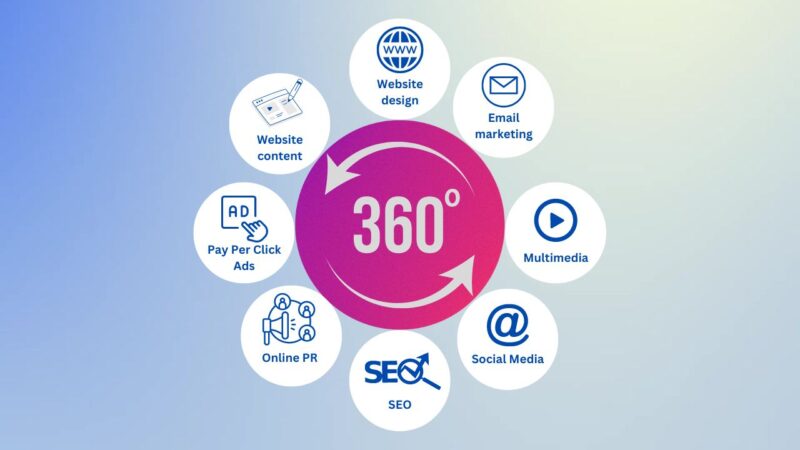Marketing has become a dynamic, fast-moving landscape, and it can feel overwhelming to stay on top of trends, platforms, and tools. One way to stay ahead of the game is through a 360-degree marketing strategy—a holistic approach that engages your audience at every touchpoint.
Let’s explore how this strategy works and how it can help your business not only survive but thrive in a competitive market.
360-Degree Marketing In a Nutshell
Picture marketing as a conversation. You don’t want to speak to someone just once and expect a lasting relationship, right? The idea behind 360-degree marketing is to talk to your customers in different ways, across multiple platforms, while keeping the conversation consistent.
From social media and email marketing to TV ads, billboards, or in-store promotions, it’s all about giving your audience a cohesive brand experience, no matter where they encounter you. Let’s break it down. Imagine launching a product campaign.
You might start with an engaging post on Instagram, followed by a blog post on your website, and then send an email to your subscribers. Maybe the campaign also includes a radio ad or a feature in a print magazine. Each channel reinforces the same core message, ensuring your brand stays top of mind as customers move from one platform to another.
Why Is It So Effective?
The real power of 360-degree marketing lies in its ability to engage your customers at different stages of their buying journey. Whether they’re discovering your brand for the first time or making a final purchase decision, this strategy ensures that they encounter a consistent message at each step.
By reaching people through multiple channels, you’re not just hoping they see your message—you’re making sure of it. When someone sees your brand repeatedly across various platforms, it’s like hearing a song over and over—it sticks. And that’s exactly what you want.
Key Components of a 360 Marketing Strategy

Let’s take a closer look at what makes up a successful 360-degree marketing strategy:
Multi-Channel Integration
Gone are the days when a single channel could do the heavy lifting for your marketing efforts. The key to 360-degree marketing is integrating multiple channels.
That includes digital spaces like social media, Google, and blogs, alongside traditional mediums like TV, radio, and print. The trick is not just to be everywhere—it’s being everywhere with intention.
Consistency is Crucial
You know that sense of comfort when you recognize a familiar face in a crowd? That’s the feeling you want to create with your marketing. Consistency across platforms, from visuals to messaging, builds trust.
Customer-Centric Messaging
Your customer’s journey is at the heart of this approach. The idea isn’t just to bombard people with messages but to meet them where they are.
It doesn’t matter if they’re discovering your product for the first time or are loyal customers looking for something new, your strategy should provide the right information, at the right time, and in the right place.
Data-Driven Decisions
The beauty of marketing today is that data is everywhere. From website analytics to social media engagement stats, you can collect information at every touchpoint.
Use that data to understand how your campaigns are performing, which channels are thriving, and where adjustments are needed. The more targeted your approach, the more likely you’ll reach the right people.
Benefits of a 360 Marketing Strategy

A 360 marketing strategy does more than just get your name out there—it brings tangible benefits that can transform how your offline or online business grows.
1. Boosting Brand Visibility
The wider your reach, the more eyes you’ll attract. By tapping into multiple channels, you’re making sure your brand is seen by a larger and more diverse audience.
Maybe one person follows you on Instagram, while another only listens to the radio. Cover all possible angles, and you will ensure everyone gets to know your brand.
2. Enhanced Customer Engagement
Consistency across channels doesn’t just help with recognition—it makes it easier for customers to interact with you.
One person might engage with your social media post, while another prefers to respond to an email. When you give people multiple options to connect, you’re more likely to build lasting relationships.
3. Increased Conversion Rates
Consistency builds trust, and trust drives conversions. The more customers see your brand across different platforms, the more likely they are to feel confident in making a purchase.
A 360 strategy leads them through their decision-making journey, reinforcing your message until they’re ready to take action.
4. Building Customer Loyalty
Long-term success in business is all about repeat customers. A personalized experience based on consistent engagement is key to fostering loyalty.
When people feel seen and heard by your brand, they’re more likely to come back. Tailored content, personalized email offers, or targeted social media ads can all help solidify those lasting relationships.
5. Flexibility and Adaptability
A huge perk of a 360 marketing approach is its adaptability. With data at your fingertips, you can quickly identify what’s working and what’s not.
If one channel isn’t performing, you can pivot, adjust your message, or shift focus to a higher-performing platform. It keeps your strategy agile, ensuring your resources are spent where they’ll have the most impact.
Steps to Create a Winning 360 Marketing Strategy

Now that you know why this approach works, let’s break down how you can create your own 360-degree marketing strategy.
1. Know Your Audience
Who are you talking to? The first step is to get clear on who your target audience is. Collect data on their habits, preferences, and where they spend time online or offline.
Are they more likely to be on Facebook, or are they podcast enthusiasts? Knowing this will help you focus your efforts on the channels that matter most.
2. Consistent Messaging, Everywhere
Once you know your audience, develop a consistent message that resonates across all channels. Whether you’re posting on social media, running an email campaign, or creating print ads, your tone, style, and visuals should align.
This makes it easier for your audience to recognize and connect with your brand.
3. Pick the Right Channels
It’s tempting to be everywhere, but not every channel is going to be a good fit for your brand. Consider your audience’s habits and preferences when deciding where to focus.
Social media might be huge for one brand, while another thrives on email campaigns or traditional media like TV and radio.
4. Leverage Data
Data is your best friend. Use it to track your campaigns’ performance, from engagement rates to conversion numbers.
This helps you see what’s working and where you need to tweak things. A successful 360-degree marketing strategy is always driven by real-time data and continuous optimization.
5. Personalization is Key
One-size-fits-all marketing doesn’t cut it anymore. Use data to personalize your campaigns. Segment your audience into groups based on their behavior or preferences and tailor your messaging accordingly.
Personalized email campaigns, targeted social media ads, or product recommendations can make a big difference in connecting with your customers.
6. Constant Monitoring and Optimization
Your work isn’t over once the campaign is live. Regularly monitor all your platforms, assess what’s working, and make adjustments as needed.
If one channel is underperforming, tweak your approach or shift your budget to focus on channels that are driving better results.
Wrapping It Up
At its core, 360-degree marketing is about showing up where your customers are and offering them a seamless, engaging experience. By utilizing multiple platforms, keeping your messaging consistent, and being adaptable, you can build a strong brand presence that stands out in the market.
The benefits are clear: from increased visibility and engagement to higher conversion rates and customer loyalty, a 360 marketing strategy is the key to long-term success.
It helps you connect with your audience in meaningful ways and ensures that your brand is not just seen but remembered. And in today’s fast-paced world, that’s what makes all the difference.

